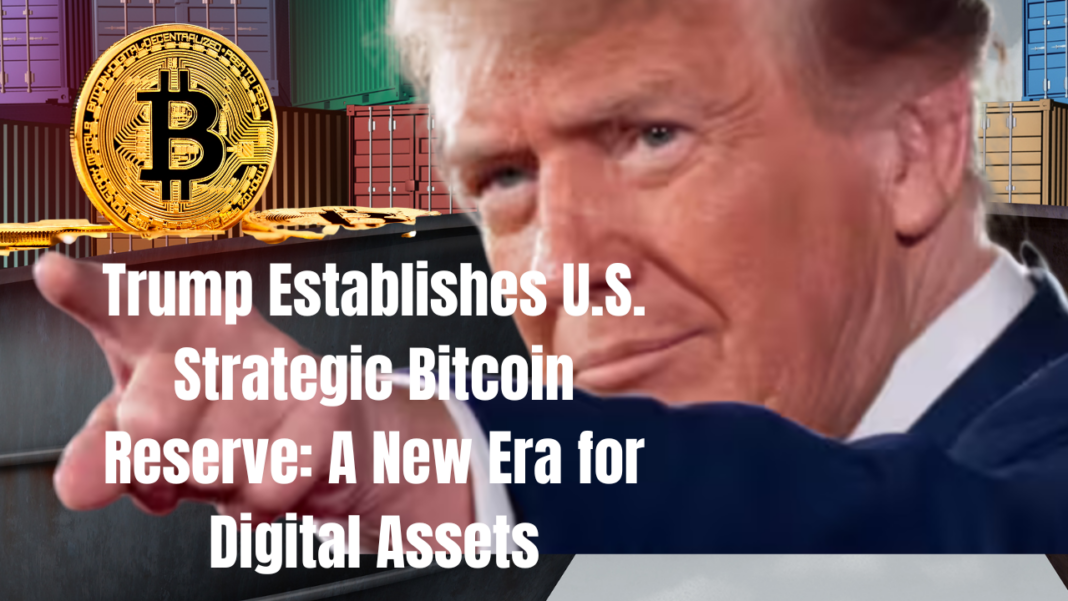President Donald J. Trump has signed an Executive Order to establish a Strategic Bitcoin Reserve and a U.S. Digital Asset Stockpile, marking a significant shift in the U.S. government’s approach to digital assets. This move positions the United States as a leader in government-held cryptocurrency reserves and digital asset strategy.
A New Era for Bitcoin as a U.S. Reserve Asset
The Executive Order creates a Strategic Bitcoin Reserve, recognizing Bitcoin as a long-term reserve asset for the nation. The reserve will be initially funded with Bitcoin forfeited to the Department of Treasury in criminal and civil asset forfeiture proceedings. Other federal agencies holding Bitcoin will assess their legal authority to transfer their holdings into the reserve.
In a break from past policies, the Executive Order explicitly states that the U.S. government will not sell Bitcoin held in this reserve, ensuring it remains a store of value. Additionally, the Secretaries of Treasury and Commerce have been authorized to develop budget-neutral strategies for acquiring more Bitcoin—without imposing additional costs on American taxpayers.
Creation of a Digital Asset Stockpile
Beyond Bitcoin, the order also establishes a U.S. Digital Asset Stockpile, which will hold other cryptocurrencies and digital assets seized through forfeiture proceedings. Unlike Bitcoin, these assets may be subject to potential sales or other management strategies as determined by the Treasury Secretary. However, the government will not actively purchase additional digital assets for this stockpile beyond those obtained through forfeiture.
A Shift in U.S. Crypto Management Strategy
The White House emphasized that the Executive Order addresses long-standing inefficiencies in the handling of forfeited digital assets. Currently, seized cryptocurrencies are scattered across multiple federal agencies without a centralized policy for oversight, accountability, or strategic management. The new order mandates that all agencies report their digital asset holdings to the Treasury Secretary and the President’s Working Group on Digital Asset Markets.
The move comes in response to previous federal mismanagement of seized Bitcoin, which the administration claims has cost taxpayers more than $17 billion due to premature sales. By centralizing control and ensuring a long-term strategic vision, the administration aims to maximize the value of government-held digital assets while providing transparency in their management.
Trump’s Vision: Making America the “Crypto Capital of the World”
The Executive Order is the latest step in President Trump’s broader crypto-friendly agenda. Since taking office, he has pledged to position the United States as a global leader in digital assets, promoting policies that embrace cryptocurrency innovation.
Key initiatives under his administration include:
- The appointment of a “crypto czar” to oversee national digital asset policies.
- The upcoming first-ever White House Crypto Summit, bringing together industry leaders and policymakers.
- A commitment to fostering an open and supportive regulatory environment for crypto-related businesses.
President Trump reiterated his strong stance on digital assets, stating:
“I am very positive and open-minded to cryptocurrency companies and all things related to this new and burgeoning industry. Our country must be the leader in the field.”
Implications for the Crypto Market and the Global Economy
The establishment of a Strategic Bitcoin Reserve signals a shift in how governments view Bitcoin—not just as a speculative asset, but as a legitimate store of value akin to gold. With a fixed supply of 21 million coins, Bitcoin has often been referred to as “digital gold,” and Trump’s Executive Order positions the U.S. ahead of other nations in accumulating Bitcoin as a strategic reserve asset.
Market analysts suggest this move could have long-term bullish effects on Bitcoin’s price and adoption. By committing to not selling Bitcoin in the Strategic Reserve, the U.S. government is effectively reducing market supply, potentially driving up demand and valuation.
Meanwhile, the Digital Asset Stockpile allows flexibility in managing other forfeited cryptocurrencies, potentially giving the Treasury a tool to generate revenue from sales when appropriate.
Conclusion
With this landmark Executive Order, President Trump is taking an unprecedented step toward integrating Bitcoin into the U.S. financial strategy. By recognizing Bitcoin as a reserve asset, centralizing control over seized digital assets, and promoting crypto-friendly policies, the administration is laying the groundwork for the United States to become a global leader in digital assets.
As the world watches, the move may encourage other nations to follow suit, further legitimizing Bitcoin’s role in the global financial system. Whether this strategy ultimately strengthens the U.S. economy remains to be seen, but one thing is certain: America’s digital asset policy has entered a new era.
A global media for the latest news, entertainment, music fashion, and more.





